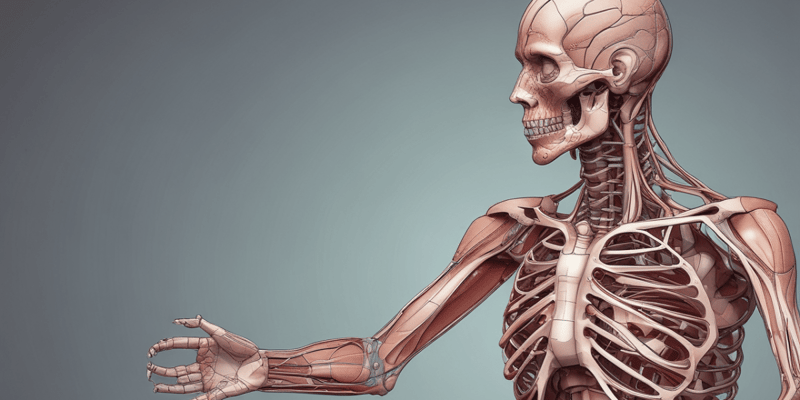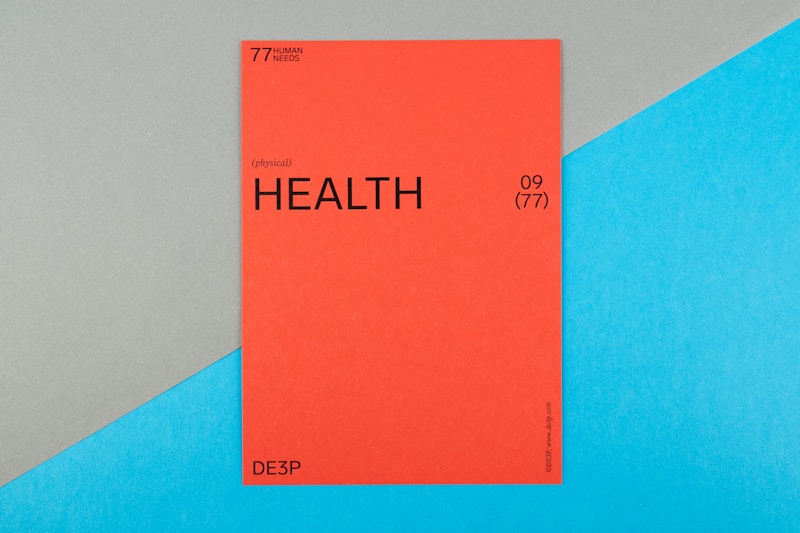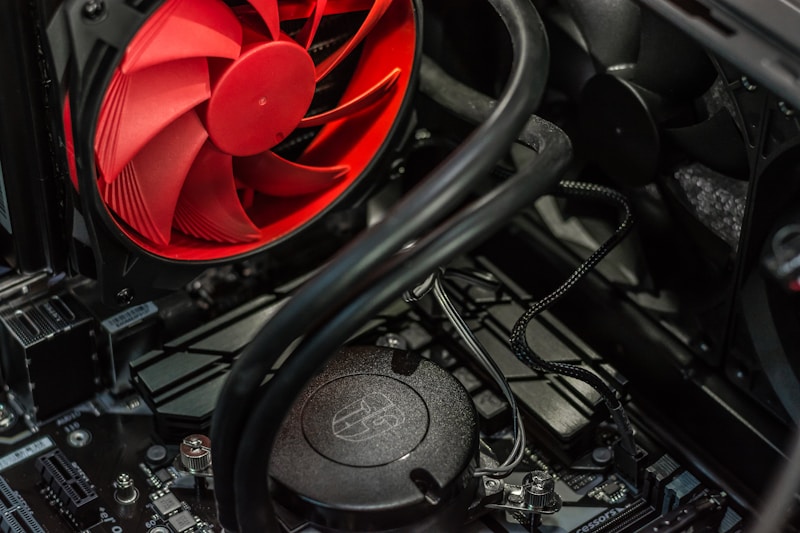Podcast
Questions and Answers
What is the function of the auricle on the anterior surface of the heart?
What is the function of the auricle on the anterior surface of the heart?
Where is the left atrium located?
Where is the left atrium located?
What is the function of the pulmonary trunk?
What is the function of the pulmonary trunk?
What is the curved part of the aorta?
What is the curved part of the aorta?
Signup and view all the answers
What are the three vessels that come off the aortic arch?
What are the three vessels that come off the aortic arch?
Signup and view all the answers
What is the superior vena cava formed by?
What is the superior vena cava formed by?
Signup and view all the answers
What is the function of the pulmonary arteries?
What is the function of the pulmonary arteries?
Signup and view all the answers
What is the purpose of the coronary circuit?
What is the purpose of the coronary circuit?
Signup and view all the answers
What are the two main coronary arteries?
What are the two main coronary arteries?
Signup and view all the answers
What is a branch of the left coronary artery?
What is a branch of the left coronary artery?
Signup and view all the answers
What is the function of the great cardiac vein?
What is the function of the great cardiac vein?
Signup and view all the answers
What is an anastomosis?
What is an anastomosis?
Signup and view all the answers
What is the function of the right atrium?
What is the function of the right atrium?
Signup and view all the answers
What is the purpose of the chordae tendineae?
What is the purpose of the chordae tendineae?
Signup and view all the answers
What is the fossa ovalis?
What is the fossa ovalis?
Signup and view all the answers
What is the coronary sinus?
What is the coronary sinus?
Signup and view all the answers
What is the purpose of the mitral valve?
What is the purpose of the mitral valve?
Signup and view all the answers
What is the myocardium?
What is the myocardium?
Signup and view all the answers
What is the epicardium?
What is the epicardium?
Signup and view all the answers
What is the function of the pectinate muscles?
What is the function of the pectinate muscles?
Signup and view all the answers
Study Notes
Anterior Surface of the Heart
- The anterior surface of the heart has an auricle (fatty pouch) on the left and right sides, which has muscle tissue to squeeze blood into the atria.
- The left atrium is located behind the left auricle.
- The pulmonary trunk takes deoxygenated blood from the right ventricle to the lungs to get oxygenated, which is why it appears blue.
Aorta and Branches
- The aorta is a large vessel that comes out of the heart.
- The ascending aorta is the portion of the aorta that comes out of the heart.
- The aortic arch is the curved part of the aorta.
- Three vessels come off the aortic arch: brachiocephalic artery, left common carotid artery, and left subclavian artery.
Right Side of the Heart
- The right atrium is the upper chamber of the heart.
- The superior vena cava is a large vein that dumps into the right atrium.
- The superior vena cava is formed by the merger of the left and right brachiocephalic veins.
- The azygos vein is a small vein that feeds into the superior vena cava.
Posterior Surface of the Heart
- The posterior surface of the heart has the pulmonary arteries (right and left) and the aorta (descending).
- The pulmonary arteries are deoxygenated vessels that take blood to the lungs to pick up oxygen.
- The pulmonary veins are oxygenated vessels that bring blood back to the heart.
Coronary Circuit
- The coronary circuit is the circulation of blood to the heart muscle itself.
- The coronary arteries come off the aorta and supply oxygen to the heart muscle.
- The right coronary artery and left coronary artery are the two main coronary arteries.
- The anterior interventricular artery (also known as the left anterior descending artery) is a branch of the left coronary artery.
- The circumflex artery is another branch of the left coronary artery.
- The marginal artery is a branch of the right coronary artery.
- The posterior interventricular artery is a branch of the right coronary artery.
Veins of the Heart
- The great cardiac vein is a vein that runs next to the anterior interventricular artery and drains the myocardium.
- The posterior vein of the left ventricle is a vein that drains the myocardium.
- The small cardiac vein is a vein that drains the myocardium.
- The middle cardiac vein is a vein that drains the myocardium.
Anastomoses
- Anastomoses are alternative routes for blood to flow in case of a blockage.
- The marginal artery and posterior interventricular artery have an anastomosis.
- The circumflex artery and posterior interventricular artery have an anastomosis.
- The anterior interventricular artery and circumflex artery have an anastomosis.
- The marginal artery and anterior interventricular artery have an anastomosis.
Inside the Heart
- The right atrium is the upper chamber of the heart.
- The tricuspid valve separates the right atrium from the right ventricle.
- The chordae tendineae are collagen cords that anchor the valve leaflets to the papillary muscles.
- The fossa ovalis is a scar tissue in the right atrium that is formed from the closure of the foramen ovale.
- The coronary sinus is a vein that collects blood from the heart muscle and drains into the right atrium.
- The right ventricle is the pumping chamber of the heart.
- The pulmonary semilunar valve separates the right ventricle from the pulmonary trunk.
- The ligamentum arteriosum is a ligament that closes off the ductus arteriosus after birth.
Left Side of the Heart
- The left atrium is the upper chamber of the heart.
- The left pulmonary veins dump oxygenated blood from the left lung into the left atrium.
- The mitral valve (or bicuspid valve) separates the left atrium from the left ventricle.
- The chordae tendineae are collagen cords that anchor the valve leaflets to the papillary muscles.
- The aortic semilunar valve separates the left ventricle from the aorta.
- The interventricular septum is the wall of tissue that separates the right and left ventricles.
Heart Muscle and Lining
-
The myocardium is the muscular layer of the heart.
-
The endocardium is the lining of the internal chambers of the heart and valves.
-
The pectinate muscles are muscle linings in the anterior walls of the atria.
-
The trabeculae carne are irregular fibers of muscle in the anterior walls of the ventricles.### Heart Anatomy
-
The outer layer of the heart is composed of the epicardium, which is made up of simple squamous epithelial tissue and a little areolar connective tissue.
-
The epicardium is also referred to as mesothelium.
-
The epicardium covers the outer part of the heart.
Additional Notes
- The pectinate muscles are located in the anterior walls of the atria.
- The anterior walls of the ventricles also have a specific structure.
Anterior Surface of the Heart
- The anterior surface has an auricle on the left and right sides, which has muscle tissue to squeeze blood into the atria.
- The left atrium is located behind the left auricle.
Aorta and Branches
- The aorta is a large vessel that comes out of the heart.
- The ascending aorta is the portion of the aorta that comes out of the heart.
- The aortic arch is the curved part of the aorta.
- Three vessels come off the aortic arch: brachiocephalic artery, left common carotid artery, and left subclavian artery.
Right Side of the Heart
- The right atrium is the upper chamber of the heart.
- The superior vena cava is a large vein that dumps into the right atrium.
- The superior vena cava is formed by the merger of the left and right brachiocephalic veins.
- The azygos vein is a small vein that feeds into the superior vena cava.
Posterior Surface of the Heart
- The posterior surface has the pulmonary arteries (right and left) and the aorta (descending).
- The pulmonary arteries are deoxygenated vessels that take blood to the lungs to pick up oxygen.
- The pulmonary veins are oxygenated vessels that bring blood back to the heart.
Coronary Circuit
- The coronary circuit is the circulation of blood to the heart muscle itself.
- The coronary arteries come off the aorta and supply oxygen to the heart muscle.
- The right coronary artery and left coronary artery are the two main coronary arteries.
- The anterior interventricular artery is a branch of the left coronary artery.
- The circumflex artery is another branch of the left coronary artery.
- The marginal artery is a branch of the right coronary artery.
- The posterior interventricular artery is a branch of the right coronary artery.
Veins of the Heart
- The great cardiac vein runs next to the anterior interventricular artery and drains the myocardium.
- The posterior vein of the left ventricle drains the myocardium.
- The small cardiac vein drains the myocardium.
- The middle cardiac vein drains the myocardium.
Anastomoses
- Anastomoses are alternative routes for blood to flow in case of a blockage.
- The marginal artery and posterior interventricular artery have an anastomosis.
- The circumflex artery and posterior interventricular artery have an anastomosis.
- The anterior interventricular artery and circumflex artery have an anastomosis.
- The marginal artery and anterior interventricular artery have an anastomosis.
Inside the Heart
- The right atrium is the upper chamber of the heart.
- The tricuspid valve separates the right atrium from the right ventricle.
- The chordae tendineae are collagen cords that anchor the valve leaflets to the papillary muscles.
- The fossa ovalis is a scar tissue in the right atrium that is formed from the closure of the foramen ovale.
- The coronary sinus is a vein that collects blood from the heart muscle and drains into the right atrium.
- The right ventricle is the pumping chamber of the heart.
- The pulmonary semilunar valve separates the right ventricle from the pulmonary trunk.
- The ligamentum arteriosum is a ligament that closes off the ductus arteriosus after birth.
Left Side of the Heart
- The left atrium is the upper chamber of the heart.
- The left pulmonary veins dump oxygenated blood from the left lung into the left atrium.
- The mitral valve separates the left atrium from the left ventricle.
- The chordae tendineae are collagen cords that anchor the valve leaflets to the papillary muscles.
- The aortic semilunar valve separates the left ventricle from the aorta.
- The interventricular septum is the wall of tissue that separates the right and left ventricles.
Heart Muscle and Lining
- The myocardium is the muscular layer of the heart.
- The endocardium is the lining of the internal chambers of the heart and valves.
- The pectinate muscles are muscle linings in the anterior walls of the atria.
- The trabeculae carne are irregular fibers of muscle in the anterior walls of the ventricles.
Heart Anatomy
- The outer layer of the heart is composed of the epicardium, which is made up of simple squamous epithelial tissue and a little areolar connective tissue.
- The epicardium is also referred to as mesothelium.
- The epicardium covers the outer part of the heart.
Additional Notes
- The pectinate muscles are located in the anterior walls of the atria.
- The anterior walls of the ventricles also have a specific structure.
Studying That Suits You
Use AI to generate personalized quizzes and flashcards to suit your learning preferences.



